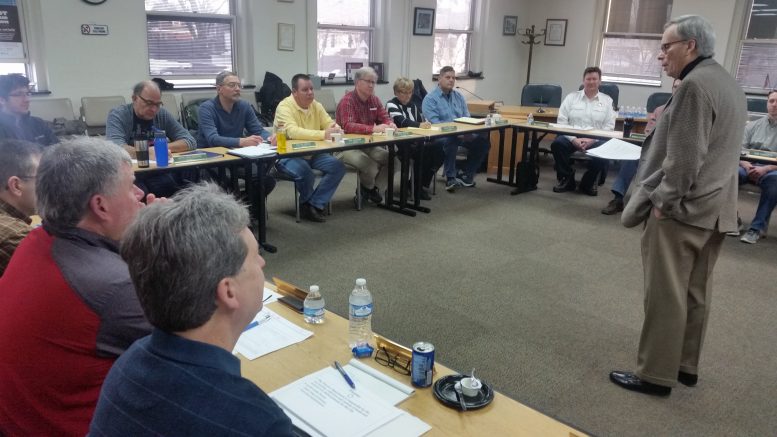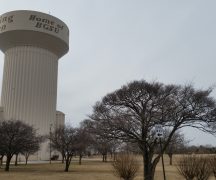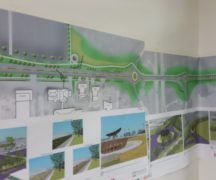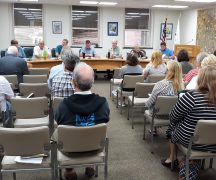By JAN LARSON McLAUGHLIN
BG Independent News
Neighborhood revitalization, food trucks, more cameras in the downtown bar district, and code enforcement by police made the list of 2018 goals for Bowling Green city officials.
City department heads listed their top priorities for the year during a work session held Saturday morning for city council. Mayor Dick Edwards set the tone.
“This is going to be a very ambitious year, and if we think otherwise, we’ll get smacked right in the face with it,” Edwards said. The mayor repeated some of the projects he mentioned at last week’s council meeting, including progress on Wooster Green, East Wooster corridor, and new City Park building.
Unlike those highly visible projects, the city will also be updating its charter – making sure the effort is “citizen-driven,” Edwards said. And efforts will be made to define the city’s goal of being a “welcoming community.”
The mayor talked about the city’s goal to become more diversified industrially. Sue Clark, the city’s economic development director, has reported increased interest in the city. “The phone has been ringing off the wall,” Edwards said.
“It spells a very promising picture for 2018,” Edwards said, noting the importance of economic growth to city services.
Edwards revisited a topic that consumed much of last year – the Nexus pipeline. “That was gut-wrenching at times for all of us. That’s going to be a special challenge for us in 2018,” he said. City officials still have not been given a timeline for the pipeline construction.
Concerns continue, the mayor said, about state legislation that could have negative effects on municipalities. Edwards has talked with State Sen. Randy Gardner and State Rep. Theresa Gavarone, both R-Bowling Green, about the state’s plans for 2018.
“They keep talking in very positive terms about supporting local government,” Edwards said about state officials. “All the words coming out of Columbus are encouraging, but the proof is in the pudding.”
The mayor also took time to try resurrecting the city historic preservation effort that was started and then dropped.
“I would at least like to get something before you that you can address,” he said to council. Cities like Toledo are taking advantage of tax credits to revitalize downtown historic areas. Bowling Green could do the same, Edwards said.
“Other communities have really been benefitting from this,” he said.
Each of the city’s department heads also listed some goals for 2018.
Municipal Administrator Lori Tretter said she would like to work on updating city regulations for permitting peddlers, solicitors and itinerant merchants. That includes regulations for food trucks.
“We get many, many calls about this,” Tretter said. The current rules require 150 feet of right-of-way between food trucks and the roadway. “This ordinance has not been updated in a very long time.”
Finance Director Brian Bushong will be working on bond rating and issuance for the I-75 interchange roundabouts and the City Park building. Bushong said the city will likely have to borrow money again in 2019, since efforts will be made to stay under $10 million in 2018.
The city’s finance office is also working to replace its paper timecards for hourly employees. The new “Executime” process will eliminate paper and streamline the process, Bushong said.
Parks and Recreation Director Kristin Otley talked about the new City Park building which will replace the existing Veterans Building, Girl Scout Building and the Depot. Construction is expected to begin this August and be completed by late spring in 2019.
“We’re very excited about that,” Otley said.
The parks and rec department also plans to level and seed the remaining acreage behind the community center, pave a trail from the center parking lot to the fields, and add handicapped parking spaces near the fields, she said.
Planning Director Heather Sayler said her office is planning to scan at least 250,000 documents that are permanent records. That change is expected to make the office much more efficient.
The planning office will also be finalizing the Community Action Plan and deciding the next steps to implement the plan. That will likely include working on the zoning code and subdivision regulations, Sayler said. A joint meeting of City Council and the planning commission will be held Feb. 28, at 6 p.m., in the courthouse atrium, to review the CAP results.
Public Works Director Brian Craft said work will continue on the East Wooster Street corridor improvements, with utility work to be done this year for the roundabout projects. The “more heavy-duty roadwork” on East Wooster will take place in 2019, with efforts being made to keep businesses aware of the progress, he said.
Work will also begin on the paving phase of Manville Avenue, and the Conneaut force main/pump station project, Craft said.
Main Street from the Wood County Senior Center to Ordway Street will also be repaved, with the brick section to be returned to the four corners area downtown, he said.
Bill Moorman, who will be sworn in as the city’s new fire chief at the next council meeting, reported on the fire division’s priorities. The department will continue working on risk reduction inspections, which were started last year. The city has approximately 1,400 locations – primarily businesses – to inspect.
The goal is to conduct 45 new inspections and 45 re-inspections each month, while focusing on education and safety, Moorman said. So far, 340 initial and 350 re-inspections have been performed.
“We’ve had a lot of cooperation from the business owners,” he said. “It’s a big undertaking.”
The fire division will also work on its reaccreditation, with officials to visit later this year. The department has made improvements in dispatching, automatic volunteer aid, and getting rid of communication dead spots in the city, Moorman said.
Police Chief Tony Hetrick said one of his goals is to upgrade to downtown camera system. High resolution cameras will be installed in the 100 block of North Main Street to supplement the cameras at the four corners and in City Lot 2. The new cameras will replace obsolete cameras and piggyback with the paving project planned for downtown.
“They will be eyes in areas that we consider our high crime areas in the bar district,” Hetrick said. The bars areas aren’t known for much “witness participation,” the chief said. The new cameras will provide images so crisp that police will be able to read license plates and see faces clearly, he said.
The next area for cameras will be the 100 block of South Main Street, the downtown blocks of Wooster, and the city parking lots.
Hetrick also said the police division is researching the feasibility of using parking and animal control officers to supplement city code enforcement. The officers would address “quality of life” issues, such as vehicles parked in yards, inoperable vehicles, noxious weeds, tall grass and snow not removed from sidewalks in the required time.
“This is a new concept,” Hetrick said.
This parking, animal control and code enforcement staff would be merged into a Civil Enforcement Section, with all current technicians being cross-trained, and one other person being hired. This change would mean that code enforcement would be available to respond to problems during more hours, the chief said.
Public Utilities Director Brian O’Connell said one of his goals is to achieve financial stability in the city’s sewer revenue fund. The city has seen reduced revenue and increased costs, so some sewer rate adjustments may be needed, he said.
O’Connell also wants to reduce the electric power supply costs. The city has no control over transmission and capacity costs, but the expansion of electric sales will help. The utilities office is still considering working on another solar field – this one on Wood County land off East Gypsy Lane Road, he said.





